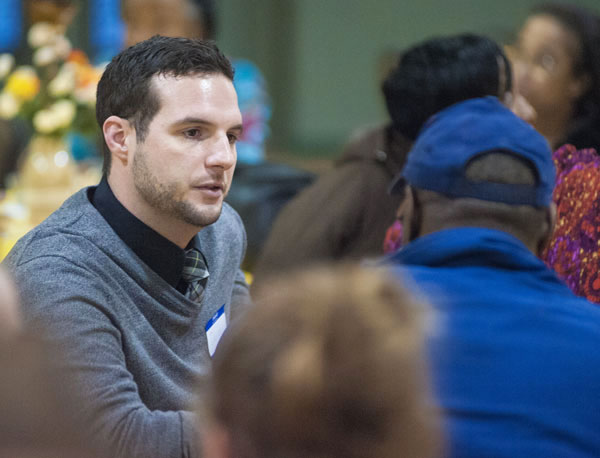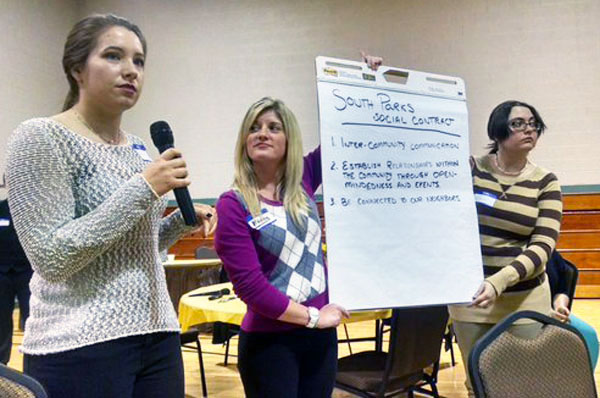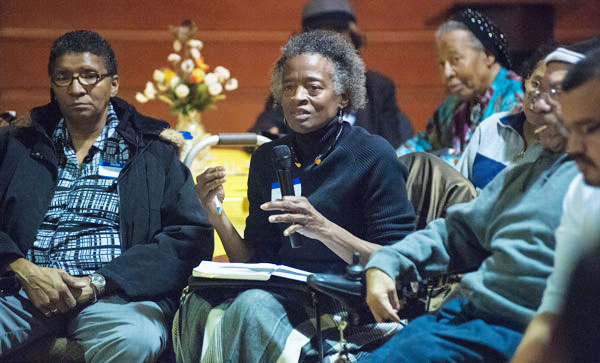UM-Flint Education Students Connect with Flint's South Parks Neighborhood

The secondary education students at the UM-Flint see their pathway as future educators through a modern lens that broadens their perspective of the links between communities and schools.
Students in SEC 200 "Community, Family, Self" recently completed a course project that took that concept to the people of Flint's South Parks Neighborhood.
Led by co-teachers Annie Whitlock and Danielle De La Mare, the class of 27 students presented a student-directed documentary last week of their findings about the neighborhood, followed by a discussion with a group of South Parks residents at Brennan Community Center.
The project is one of the first representing UM-Flint's place-based approach to teaching and learning, emphasizing community engagement and preparing aspiring teachers to work with diverse populations while combining their knowledge of content specialization with newly-acquired pedagogical skills.

The South Parks Neighborhood lies in the area south of I-69 and east of I-475. The students took walking tours of the neighborhood, interviewed residents, researched the neighborhood's history, and studied its current needs in the categories of child care, education, transportation, utilities, open spaces, food, and housing.
While researching the area, the students learned from residents about the negative impacts of the development of I-475 cutting through their neighborhood, the demise of the auto industry, subsequent school closings, an influx of crime, and an exodus of homeowners. These and other problems have shaped the depressed neighborhood into one that still struggles to renew its identity.
UM-Flint students learned that a lack of locally-based licensed child care facilities and school closings, resulting in children being transported to schools away from their neighborhood, have caused difficulties for families. "A lot of the moms here are single moms and working, and there's a lack of supervision for their kids," said student Carrie Holmes. "Kids are seeing kids in other neighborhoods."
Student Tricia Soper is familiar with Flint's Master Plan and many of the city's efforts to move forward. "It's cool seeing more U of M students getting involved in the community," she said. "Our involvement here is learning about the community and being a resource for them to help them see that they can take that step of action."
Along with budgeting and planning the presentation event, students created a brochure for new South Parks residents and an informative website of their project that they will turn over to the neighborhood association as a resource for future improvements.
Following the presentation, residents were more determined to increase the neighborhood's opportunities for socializing and building supportive relationships with one another across generations. Student Karlee Ringle led the conversation, encouraging residents to determine for themselves what it means to live in a community and to come up with realistic ways to improve their neighborhood. The South Parks Neighborhood Association has recently developed a playscape for kids, and residents are discussing the development of a pavilion next spring.
Doris Keels has lived in the South Parks Neighborhood all of her life and remembers when families looked after each other all of the time. "When we were growing up, we had neighbors and if I did something wrong, my parents knew even before I came home," she said. "You didn't have to go out of the community to get what you need. Now it's like there is no connection with the young people. They don't care about you 'til you care about them. When they care about you, they've got your back."
Sandra E. Robinson is a member of the South Parks Neighborhood Association, a mother of seven, and a retired teacher for Flint Community Schools. She said the community was once vibrant and involved, but now its residents are disconnected. The closings of Stewart and Scott elementary schools have been tough for the community.

"These children are going to all different schools so it's hard to get that cohesiveness," she said. "I still have connections with the people I grew up with. My children felt valued because the adults in their lives put things in place to make sure their needs were addressed. You want your family as a community to care."
The UM-Flint students' project has given the neighborhood's situation "fresh eyes" and more motivation for reconnecting people, Sandra said. "If you see how you got to where you are, then you can avoid those traps and move forward in a more positive and productive way," she said.
Related Posts
No related photos.
UM-Flint News
The Office of Marketing & Communications can be reached at mac-flint@umich.edu.